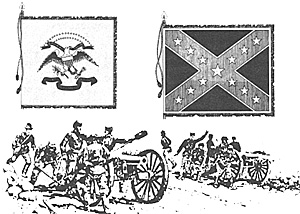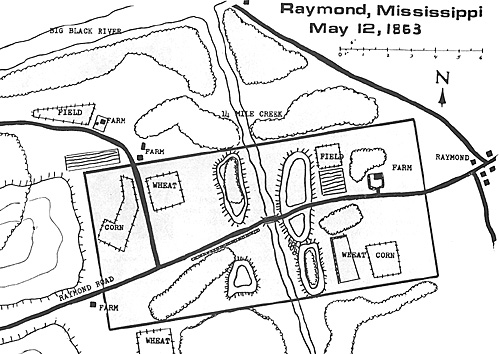 UNION ORDERS:
UNION ORDERS:
You are in the vanguard of Grant's Army as it moves toward Jackson, Mississippi. General Grant wants the advance to be rapid, in order to prevent reinforcements from reaching Jackson. By capturing Jackson, Grant will have cut off the last outside link to Vicksburg.
Your division is leading the advance of McPherson's Corps. On the left are the corps of Sherman and McClerand. McPherson has made it clear that he wants his corps to reach Jackson first. Your brigades are proceeding along the Raymond Road about one mile west of 14 Mile Creek, near Raymond, Mississippi. The march objective for the day is Raymond. The day's march has gone rapidly with little rebel resistance.
Your brigades will arrive on the board by the Raymond Road as follows;
- 1000AM 1st Brigade;
1100AM 2nd Brigade;
1200AM Brigade artillery;
1:00PM 3rd Brigade.
The immediate mission of your division is to clear the Raymond Road to Raymond. Success of your mission will be judged on how rapidly you can reach Raymond and what the cost in material and men is, You have the option to switch the brigade order of march if you so desire.
Victory Conditions
Superior; Capture Raymond in less than five hours, suffer less than 410 casualties.
Average: Capture Raymond in less than 7 hours, suffer less than 600 casualties.
Poor: Capture Raymond in over 7 hours, suffer more than 600 casualties, lose any artillery or supply equipment.
(Note; Time requirements start 12:00 AM).
Confederate Orders
Assume blocking position west of Raymond on road. Grant's army is marching towards Raymond, attempting to cut supply lines to Vicksburg. You must stall for as long as possible to give Gen. Johnson time to assemble a force for the defense of Jackson. General Pemberton has instructed you to hold Raymond. However, "If the enemy advance on you is too strong, fall back on Jackson." Your brigade should be deployed east of 14 Mile Creek. At your discretion, two of your regiments had time to dig-in upon arriving at your position.
Victory Conditions
Superior: Stall union advance for at least 7 hours suffer less than 600
casualties (killed, wounded or prisoners.
Average: Stall Union advance for at least 5 hours, suffer less than 900 casualties.
Poor; Stall union advance less than 5 hours, suffer more than 900. casualties.
Union Forces OOB
Field Commander - General John A. Logar
3rd Division XVII, CORPS
1st Brigade (M.F. Force)
- 20th Illinois 30th Illinois 31st Illinois 45th Illinois
2nd Brigade
- 20th Ohio 32nd Ohio 68th Ohio 78th Ohio
3rd Brigade
- 16th Wisconsin 17th Wisconsin Worden's Battalior
Artillery
- 4 gun 12lb Smoothbore, 4 gun 10lb Parrott, 6 gun 3" rifle
All inf. reg 600 men All inf. reg average All art. bty veterans
Confederate Forces OOB
Field Commander - General J. Gregg
Gregg's Brigade
- 3r Tennessee 10th Tenn 30th Tenn 41st Tenn 50th Tenn
1st Tenn Battalion 7th Texas
Artillery
- 4 gun 12 lb smoothbore, 4 gun 12 lb Whitworth
All infantry regiments 480 men and veterans
Historical Outcome:
Arriving at Raymond on May 11, 1863, Gen. Gregg was hailed by the town's populace as their savior. A Union column was quickly approaching moving toward Jackson. Gregg moved his brigade to a blocking position along 14 Mile Creek east of Raymond.
On May 12, 1863, a strongly contested engagement took place. The Union Corps that was bearing down on the Confederate Brigade was McPherson's, with "Blackjack" Logan's 3rd Division in the lead. The Union forces had overwhelming numbers but misread the Confederate strength, a natural mistake as no one could believe a brigade would challenge a corps to a pitched battle. The Confederates kept attacking, hitting advancing Union regiments and forcing them to retreat. Logan had to rally regiments along the entire line. The whole battlefield was a bowl of dust and smoke, making visibility very poor. The Confederates would probably not have fought had they known what they were up against.
This was not how a battle between a brigade and a corps was supposed to go. Whenever a Union regiment appeared, the Rebels facing it would move forward, finding that the best defense was a good offense. By late afternoon, Gen. Gregg had prisoners from over 12 different regiments and knew that he was in a pitched battle with a corps. Finding himself nearly surrounded, Gregg retired. One Confederate brigade had held up a Union corps for half a day. Confederate losses were 900 casualties or missing. McPherson had 442 men as casualties or missing.

Back to MWAN # 23 Table of Contents
Back to MWAN List of Issues
Back to MagWeb Magazine List
© Copyright 1986 Hal Thinglum
This article appears in MagWeb.com (Magazine Web) on the Internet World Wide Web.
Other articles from military history and related magazines are available at http://www.magweb.com